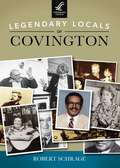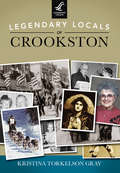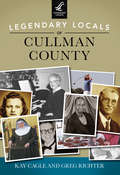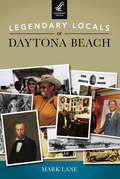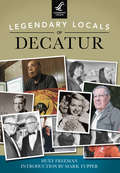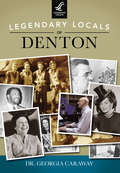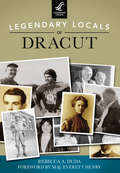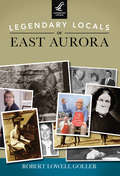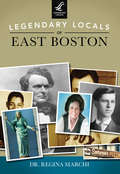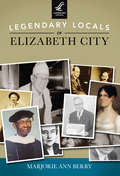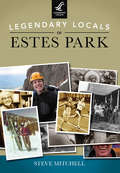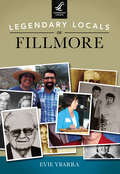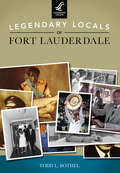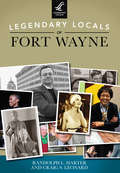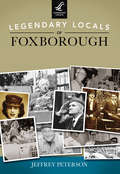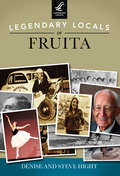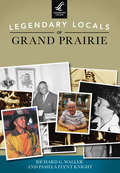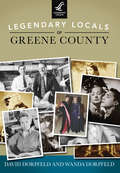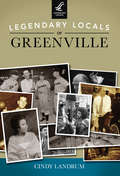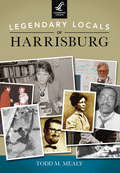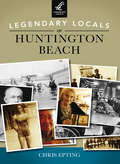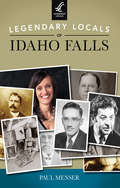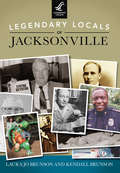- Table View
- List View
Legendary Locals of Concord (Legendary Locals)
by Lorraine A. CourtneyThe land now called Concord was originally inhabited by the Abenaki people and the Penacook tribe. Concord's first settlers, such as Ebenezer Eastman, began laying out the Plantation of Penacook, as it was known in 1725, along the fertile fields of the Merrimack River. It was incorporated in 1734 as Rumford and then renamed to Concord by Gov. Benning Wentworth in 1765. Concord experienced a surge in transportation and manufacturing in the 19th century, producing the Concord Coaches, Prescott Pianos, and steam boilers. As Concord celebrates its 250th anniversary, the city flourishes as the state capital and has a thriving community of restaurants, entertainment, and culture for all to enjoy. It retains its town sensibility as it plans for the continued growth of the local economy. Today's civic leaders, like Byron Champlin and James Carroll, work conjointly with business leaders, such as Tom Arnold of Arnie's and Juliana Eades of the New Hampshire Community Loan Fund, to build and enhance Concord's cultural, social, and economic identity.
Legendary Locals of Covington (Legendary Locals)
by Robert SchrageCovington was a natural place for people to settle. Located on the banks of the Ohio and Licking Rivers, it developed quickly as the urban core of northern Kentucky. Sitting just opposite of Cincinnati, Ohio, it was a great location for travel by both animals and people. Originally owned by Thomas Kennedy, the land was ultimately purchased by Thomas Carneal and John and Richard Gano, and thus the city of Covington was founded in 1815. Not long after its establishment, railroads made Covington their home and many other businesses followed. By 1850, it was the second-largest city in Kentucky. Over its 200 years, Covington has seen many people play a role in its history, development, and reputation. Some are great business and community leaders. Others made tremendous contributions to the arts, and some are notorious. A community is defined more by its people than its buildings and streets. The individuals who have lived and worked in Covington provide a colorful insight into its past. From its founding until the present day, these individuals are a fascinating look into the city's history.
Legendary Locals of Crookston
by Kristina Torkelson GrayCrookston is in the heart of the fertile Red River Valley. Railroad baron James J. Hill positioned the city to be a hub of transportation, so Civil War veterans and railroad workers settled Crookston first. At Hill's behest, a long tradition of learning how to "farm smart" started with the Northwest School of Agriculture in 1906. Facing a short growing season, farmers stayed close to the soil and invented better implements to harvest the area's bounty. The tradition of improving technology continues from the century-old practices begun at the Experiment Station. Currently, precision agriculture is taught at the University of Minnesota, Crookston's "laptop university." Familiar family names from Crookston's retail sector have prevailed throughout the farmers' cycle of boom and bust. Many other talented personalities shine through, especially those skilled in sports and music. Also included in this volume are unsung heroes for their acts of kindness and volunteerism.
Legendary Locals of Cullman County (Legendary Locals)
by Greg Richter Kay CagleIn search of opportunity and freedom from oppression, European emigrants boarded ships, leaving behind their ancestral homes. They carved new lives from the unknown wilderness in the American South. The Speegle family settled in what would become southwest Cullman County, and the Brindley family claimed lands to the north. From the historic Streight's Raid exploit of the Civil War to the agricultural and social development of this region of northern Alabama, these early pioneers marched into history. In 1865, Col. Johann G. Cullmann, who was disillusioned with the anarchism in his native Germany, also sought new opportunity in America, eventually settling in Alabama. After being enticed by Colonel Cullmann's descriptive words of the area's virgin timber and fertile soils, ?ve German families joined him. Encouraged by what they found, optimism flourished, word spread, and Cullman County's destiny was set. Its growth has been constant, and, today, its expansion is propelling the area to new heights of economic prominence.
Legendary Locals of Daytona Beach
by Mark LaneSince the 1920s, Daytona Beach has sold itself as "The World's Most Famous Beach," which, while not literally true, does suggest a city with a big personality and large plans. The people in these pages contributed to that personality and made those plans. These people include Matthias Day, the Ohio industrialist, educator, inventor, and newspaper editor who founded and gave his name to the new city in 1876; Mary McLeod Bethune, the daughter of former slaves, who founded the university that bears her name "with five little girls, a dollar and a half, and faith in God"; Bill France Sr., the race driver and promoter who took stock car racing from the beach sands to a state-of-the-art track and built a racing empire; and his son, Bill France Jr., who turned NASCAR into a national pastime. Other notable Daytonans include the builders, writers, artists, rockers, promoters, business founders, educators, journalists, politicians, pioneers, bootleggers, philanthropists, sports stars, and even a dog that made the city what it is today. They come to life in historical photographs from the Halifax Historical Museum, the Florida Archives, and files of the Daytona Beach News-Journal.
Legendary Locals of Decatur (Legendary Locals)
by Huey Freeman Mark TupperA working-class city of 75,000 people on the banks of the Sangamon River and its largest lake, Decatur has a reputation for outstanding individuals with a strong community spirit and an unashamed sense of patriotism. To borrow a phrase from Adm. Chester Nimitz, in Decatur, uncommon dedication is a common virtue. Harold Miller fought at Iwo Jima with a Marine tank battalion, before serving 32 years on the Decatur Police Department. Wayne and Leslie Kent, ministers at First Christian Church, risked their freedom to bring music and encouragement to oppressed believers in the Soviet Union and Poland. George Halas, a Navy veteran, was player-coach for the Decatur Staleys football team (later the Chicago Bears), a charter franchise in the professional association that would become the NFL. Bob Fallstrom, a World War II soldier before working as a newspaper reporter and editor in Decatur for more than 65 years, has promoted numerous community causes. Legendary Locals of Decatur pays tribute to those who have made this community truly unique.
Legendary Locals of Denton (Legendary Locals)
by Dr Georgia CarawayDenton, Texas, was founded in 1857 because residents needed a location near the geographic center of Denton County to house a county seat. The city is located 39 miles north of two larger cities, Dallas and Fort Worth, and the three of them form what is often referred to as the "Golden Triangle." Denton, the peak of that triangle, is the "North Star," and its residents, past and present, certainly are superstars--superstars such as Bob Rogers, the beloved "Piano Man;" Mary Evelyn Blagg Huey, a quintessential leader; and Hal Jackson, an ace war hero and lawyer. Their accomplishments burst forth from the chapters of this book to outshine others with their generosity, talents, skills, community activism, adventurous spirits, energy, civic pride, business acumen, courage, and creativity. Citizens of Denton are proud to say, "Our history defines our community." The images and words between these covers illustrate why it should be added, "And our people define our history."
Legendary Locals of Dracut
by Rebecca A. Duda Maj. Everett HenryEstablished in 1669 as a small farming village on the banks of the Merrimack River, Dracut's early settlers made their mark during the American Revolution. From French nobleman Louis Ansart, who became an American citizen and settled in the area, to Dracut's own Joseph Bradley Varnum, the town played a pivotal role in the founding of the nation. More recently, Dracut continues to be the home of modern-day patriots such as Michael Monahan, who left college to serve in the Vietnam War, and Capt. John Ogonowski, who gave his life on September 11, 2001. Dracut has been home to numerous other local legends--Dr. Christos Daoulas was the longest-serving Massachusetts school superintendent, and Dennis Piendak oversaw incredible growth and expansion during his 28 years as town manager. Dracut was also home to the indomitable Polly Urquhart, whose name now graces the corner where her store once stood; Rev. Larry Zimmerman, the pastor of the Old Yellow Meeting House for 33 years; and Edmund Murphy, the dean of Massachusetts high school football coaches. These are a few of the many amazing people who came from a town that was once known as simply "the wildernesse north of the Merrimac."
Legendary Locals of East Aurora (Legendary Locals)
by Robert Lowell GollerNestled along the banks of Cazenovia Creek, East Aurora is a cultural center of western New York State that has flourished because of the diverse talents of its people. Native Americans lived in East Aurora for thousands of years before the first settlers came to the area in 1804. One of the first pioneers, Martha Richardson Adams, carried her infant child on horseback all the way from Massachusetts. East Aurora grew rapidly after the War of 1812, evolving into an important business center south of Buffalo. By the 1880s, the village had become a horse-racing capital, where thousands came to Cicero Hamlin's farm to get a glimpse of his legendary horse, Mambrino King. As the century came to a close, hundreds of creative types were drawn to the Roycroft Campus, where Elbert Hubbard had established an arts and crafts colony. Despite modern developments, East Aurora remains a small village at heart, where the owners of the barbershop, bookstore, pharmacy, coffee shop, theater, and old-fashioned 5 & 10 still greet you at the door.
Legendary Locals of East Boston
by Dr Regina MarchiOnce a rural paradise known as "Noddle's Island," East Boston is the site of key developments in the nation's history, including the first naval battle of the American Revolution, the creation of the world's fastest sailing ships, the country's first underwater tunnel, and the nation's first public branch library. It has had its share of famous residents, from Colonial governor John Winthrop and repentant Salem witch trial judge Samuel Sewall, to clipper ship builder Donald McKay and the world's first female clipper ship navigator, Mary Patten. Women's suffrage activist Judith Winsor Smith called East Boston home, as did the first Civil War nurse, Armeda Gibbs; Massachusetts governor John Bates; and Boston mayor Frederick Mansfield. Pres. John F. Kennedy's paternal grandparents and father were born in East Boston, where they started their first businesses and political ventures, and the neighborhood has produced numerous community activists, musicians, artists, writers, and athletes.
Legendary Locals of Elizabeth City (Legendary Locals)
by Marjorie Ann BerryElizabeth City is rich in legend and lore. The pirate Blackbeard was a frequent visitor to the area, selling his ill-gotten goods to a willing populace. The Wright brothers made Elizabeth City the first leg of their trips to Kitty Hawk, and they bought materials to build their flying machine from Kramer Brothers, a local lumberyard. Champion nine-ball player Luther "Wimpy" Lassiter was born and died here. Young "Beautiful Nell" Cropsey was murdered in 1901; her death is the town's most enduring mystery. Newspaperman W.O. Saunders, editor of the Independent, was known nationally after he walked down New York's Fifth Avenue in pajamas to protest uncomfortable work attire. Young Tamsen Donner, a member of the ill-fated Donner Party, was a teacher here in the 1830s. Fred Fearing's Rose Buddies welcomed boaters to Elizabeth City with homegrown roses and wine and cheese parties. He has entertained Walter Cronkite and Willard Scott, among other luminaries. These are just a few of the stories, mysteries, and legends of Elizabeth City's past and present.
Legendary Locals of Estes Park (Legendary Locals)
by Steve MitchellIn the 1870s, ranchers Abner Sprague, William James, and Alexander MacGregor raised cattle while the Earl of Dunraven bought land for a private hunting reserve. It was neither cows nor hunting that defined Estes Park, though. Visitors were attracted to its beauty and crystalline mountain air. Inspired by conservationist John Muir, Enos Mills preserved the area's splendor by spearheading the establishment of Rocky Mountain National Park while F.O. Stanley welcomed guests to his regal Stanley Hotel, the inspiration for Stephen King's novel The Shining. As cars replaced horses downtown, Charlie Eagle Plume entertained visitors with Indian dancing, and "Casey" Martin offered children rides on his Silver Streak train. In the off-season when tourists were scarce, grocer Ron Brodie extended credit to the locals, and George Hurt ran lifts for skiers at Hidden Valley. But it was adversity that tested the town and defined its character. After the 1982 Lawn Lake Flood inundated Elkhorn businesses, town officials revitalized the downtown landscape with urban renewal. When the devastating 2013 flood washed out mountain roads and isolated Estes Park, local businesses banded together and were "Mountain Strong."
Legendary Locals of Fillmore
by Evie YbarraSince its beginning as a Southern Pacific Railroad town 100 years ago, Fillmore has been the setting of many legends and true tales, like the St. Francis Dam disaster, the 1994 earthquake, and the Hollywood film shoots. Joaquin Murietta hid in the hills, and the story of the T. Wallace More murder in Rancho Sespe in 1877 was the "murder of the century." Rancho Camulos, owned by the del Valle family until 1924, signifies the last of the Californios. Today, it is owned by the descendants of August Rubel. Tales of the sycamore tree abound, and it is an icon on Highway 126, as is the tower of the Sanitary Dairy, which was ordered from the Sears, Roebuck & Company in Chicago. Oil was discovered early in Shiells Canyon and brought Texaco to town. The fruit industry prospered, and Sunkist was welcomed. Hugh Warring installed indoor plumbing in the Piru Mansion. The likes of "Booty" Sanchez, Marcelino "Woody" Ybarra, Gene Wren, Kevin Gross, Jim Fauver, and Dorothy Shiells still influence the community.
Legendary Locals of Forest Hills and Rego Park
by Michael H. Perlman Jerry SpringerIn 1906, Cord Meyer Development Company purchased 600 acres in Whitepot and renamed it Forest Hills after its high elevation of rolling hills and proximity to Forest Park. After the Russell Sage Foundation acquired 142 acres and Grosvenor Atterbury and Frederick Law Olmsted Jr. partnered, the Forest Hills Gardens, founded in 1909, became America's earliest planned garden community. When Henry Schloh and Charles Hausmann of the Rego Construction Company came upon farmland in Forest Hills West, they renamed it Rego Park in 1923 after their slogan, "REal GOod Homes." Between the Tudor and Colonial landmarks, one can sense the footsteps of a few hundred notables who granted soul to the community and society. At the Forest Hills Tennis Stadium, imagine the Beatles landing in a helicopter in front of screaming fans in 1964, or when Althea Gibson became the first African American to win a US national tennis title in 1957. Forest Hills High School was a cornerstone for notable alumni, such as composer Burt Bacharach; musical duo Simon & Garfunkel; Bob Keeshan, who portrayed Captain Kangaroo; and the first space tourist, Dennis Tito.
Legendary Locals of Fort Lauderdale
by Todd L. BothelFrom the first settlers, the Lewis family in the 1790s, to the New River Settlement led by William Cooley in the 1830s, to the arrival of Frank Stranahan in 1893, Fort Lauderdale is an "old" young town. Named for the Second Seminole War fort commanded by Major Lauderdale, the town incorporated in 1911. The land boom of the 1910s-1920s brought an influx of people including publicist Commodore Brook, architect Francis Abreu, developer Charles Rodes, and businessmen Moe and Mack Katz. Following the economic downturn after the 1926 hurricane, the postwar boom transformed the sleepy town into the tropical paradise and tourist destination that it is today. Hotelier Bob Gill, developer James Hunt, "Crazy Gregg" Newell, and entrepreneur Wayne Huizenga led that charge. Legendary Locals of Fort Lauderdale also tells the story of groundbreaking civil servants such as Easter Lily Gates and Andrew DeGraffenreidt, civil rights activists Eula Johnson and Dean Trantalis, educators Mae McMillan and Sister Marie Schramko, and sports stars Katherine Rawls, Chris Evert, and Ryan Hunter-Reay.
Legendary Locals of Fort Wayne
by Randolph L. Harter Craig S. LeonardFort Wayne sits astride the confluence where the St. Joseph and St. Mary's Rivers form the Maumee River. Though occupied for over 10,000 years, its modern history begins just over 200 years ago with Gen. Anthony Wayne and his Miami nemesis, Chief Little Turtle. The pageant of Fort Wayne's history includes traders, industrialists, politicians, athletes, and movie stars. Included here are such notables as Hollywood's Carole Lombard and Shelley Long, Ian Rolland of Lincoln Life, Big Boy's Alex Azar, gangster Homer Van Meter, football's Rod Woodson, inventor Philo Farnsworth, and over 150 more.
Legendary Locals of Foxborough
by Jeffrey PetersonThe story of a community is best told through the stories of its people. And Legendary Locals of Foxborough by veteran journalist Jeffrey Peterson aspires to do just that. Relying heavily on newspaper files and Foxborough Historic Commission archives, Peterson introduces readers not only to the movers and shakers who made headlines over the past two centuries but also to scores of common folks with decidedly uncommon stories: E.P. Carpenter, 19th-century industrialist and visionary; E.H. and B.B. Bristol, brothers whose Foxboro Company ushered in decades of unprecedented prosperity; outsized personalities like Betty Friedmann, Al Truax, and Herb Seltsam; lanky Gene Conley, Boston Red Sox pitcher and Boston Celtics center; Alex and Sonja Spier, who fled postwar Europe to establish a local real estate empire; beloved Deerfield Academy headmaster Frank Boyden; and renowned educators John Ahern, Mabelle Burrill, and Steve Massey. Images and biographical text on these and other remarkable residents provide a delightful retrospective documenting the rich and spirited community of Foxborough.
Legendary Locals of Fruita (Legendary Locals)
by Steve Hight Denise HightNew York City poet and newspaper editor William Pabor headed to Colorado in 1870, heeding Horace Greeley's advice to "go West." After helping to establish Greeley, Colorado Springs, and Fort Collins, Pabor continued west over the Rocky Mountains and founded Fruita as a family-oriented, agrarian-based community in 1884. Since its inception, Fruita has attracted farmers, ranchers, shopkeepers, entrepreneurs, writers, and visionaries, who all came in search of community spirit and the wide-open spaces. The area has also been fertile ground for fossil hunters, and Fruita has both its own fossil, Fruitafossor windssheffeli, and its own dinosaur, Fruitadens haagarorum. Fruita is also known for its unusual characters, including a headless chicken named Mike and a feline journalist named Charlie the Cat. From the 1910 apple queen Mabel Skinner to the pizza queens, Anne Keller and Jen Zeuner, of today, presented here are just a few of the stories of Fruita's always fascinating legendary locals.
Legendary Locals of Grand Prairie
by Pamela Flynt Knight Richard G. WallerGrand Prairie is a city on the edge. Citizens have been innovators with a love for family and community. Alexander Dechmann traded land to insure a railroad depot; early settlers started schools for their families; and the police department hired one of the first women. Leaders at nonprofits such as Brighter Tomorrows not only helped the local community, but also helped develop services in surrounding communities. Business owners and volunteers have strong family traditions of giving back to Grand Prairie, and civil servants have loyalties for extended years of service, such as Ruthe Jackson and her family, who provided support for both businesses and the community. From the early settlers to today's city, Grand Prairie is built upon loyalty.
Legendary Locals of Greene County
by Wanda Dorpfeld David DorpfeldGreene County was created in 1800 from parts of Albany and Ulster Counties, and it is named after Gen. Nathanael Greene of Revolutionary War fame. Early on, the economy of the county was primarily agricultural with a few small mills and most of the settlements located along the Hudson River and its tributaries. In the early 19th century, the economy took off: people from New England began settling the mountains to the west, the Susquehanna Turnpike opened, leather tanning and brick- and pottery-making became prominent, ice was harvested and shipped to New York City, ship-building gained importance, and tourism started to be popular. Today, tourism is still important to the area, and the county features two major ski resorts. Much of Greene County is also part of the Catskill Mountain Park, which attracts many nature-lovers all year round. Over the years, county natives and transplants have made many contributions to industry, entertainment, government, military, recreation, and the arts.
Legendary Locals of Greenville
by Cindy LandrumGreenville has long been a city of visionaries. Richard Pearis settled on the banks of the Reedy River in Cherokee hunting land where few white men would venture. Max Heller, who escaped Nazi-occupied Austria as a teen, triggered the rebirth of downtown. They are some of Greenville's local legends who have seen possibilities, not limitations. They come from all walks of life. Textile leaders such as John T. Woodside, Thomas Parker, and John D. Hollingsworth transformed the city into the "Textile Capital of the World." When textiles began to fade, businessmen and leaders such as Charles Daniel, Tommy Wyche, Tom Barton, Virginia Uldrick, Dick Riley, Carl Sobocinski, and Xanthene Norris helped transform the city once again. Stories of people who have shaped Greenville with their vision, making it what it is today, fill these pages.
Legendary Locals of Harrisburg (Legendary Locals)
by Todd M. MealyWith images taken from the archives of the Dauphin County Historical Society, as well as family collections, Legendary Locals of Harrisburg encompasses biographical tributes that celebrate the deeds of actors, musicians, artists, teachers, athletes, humanitarians, politicians, veterans, firemen, and community leaders who have added a peculiar brand of Harrisburg's rich cultural tapestry. William Howard Day, an educator, and John Harris, who established Harrisburg, are two pioneers. Edward Stackpole, of Stackpole Books, and Theophilus Fenn, editor of the Telegraph, have forged the way for the city's writers. The first secretary of homeland security, Tom Ridge, and Simon Cameron, secretary of war under Lincoln, are among world-renowned politicians who have contributed to Harrisburg's valued reputation. From rival high school football coaches to dueling business owners, from civic leaders building an integrated city to aspiring young people embarking on independent journeys to the big screen, these profiles of real lives and real heroes show us that we all have contributed to the development of our own communities.
Legendary Locals of Huntington Beach
by Chris EptingFor over 100 years, Huntington Beach, a.k.a. "Surf City, USA," has come to represent the true beach culture of Southern California. Originally called Pacific City, it was when railroad magnate Henry Huntington first ran his train line down in 1904 from Los Angeles, approximately 40 miles north, that the then-quaint beach town took on the name that made it famous around the state and around the world. In 1914, the legendary George Freeth put on a surfing exhibition the day the city's vaunted concrete pier was opened, which christened Huntington Beach as a soon-to-be surfing mecca. It became a boomtown after oil was discovered in 1920 and, several decades later, morphed once again into a cradle of aerospace engineering when companies such as Boeing arrived. Throughout its tumultuous and dramatic history, Huntington Beach has always boasted a cast of colorful and profound characters. From the first mayor, Ed Manning, to Medal of Honor-recipient Chris Carr, from the Zamboni family (who invented the ice-cleaning machine) to baseball star Jeff Kent: the list is almost endless. But it is not just professional athletes, actors, and rock stars; it is the teachers, crossing guards, merchants, and activists that give Huntington Beach its well-earned reputation as one of the most interesting and charismatic cities in the state.
Legendary Locals of Idaho Falls
by Paul MenserIn 1864, a stage line driver named Matt Taylor and two associates decided Black Rock Canyon was the place for a toll bridge to handle traffic to and from Montana. The following year, their bridge opened and a town called Eagle Rock took shape. With the coming of the railroad, trains brought everyone from saloon keeper Dick Chamberlain to temperance crusader Rebecca Mitchell. To project a more genteel air, Eagle Rock became Idaho Falls in 1891. Joseph Clark, the first mayor, and newspaper publisher William Wheeler were just two of the people who helped pave the streets and turn on the lights. After assiduous wooing by boosters such as Bill Holden, D.V. Groberg, and E.F. McDermott, the Atomic Energy Commission in 1949 chose Idaho Falls for the headquarters of its National Reactor Testing Station. Today, Idaho Falls is a vital trading and service center with two hospitals, a professional baseball team, symphony orchestra, and world-class museum. It is also the hometown of some remarkable people who have gone out in the world to make names for themselves.
Legendary Locals of Jacksonville (Legendary Locals)
by Kendall Brunson Laura Jo BrunsonSince Europeans first settled along Jacksonville's riverbanks in the 16th century, the area has been a diverse community that thrives not only on commerce, music, and the arts but also on the advantages of a subtropical climate and waterside lifestyle. The city grew up around a crossing point for cattle in the St. Johns River and first became known as Cowford. The Great Fire of 1901 left 10,000 people homeless but not defeated. The ashes gave birth to a new era with strong architecture and a new resolve. Considered a friendly town for African Americans, Jacksonville was home to Harlem Renaissance artists as well as civil rights leaders. A bit laid back, the city has still managed to be on the cutting edge--it was the home of the Navy's Blue Angels as well as Southern rock and one of the country's first skateboard parks.

